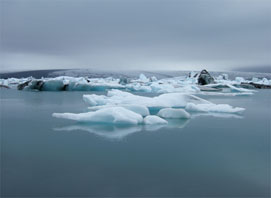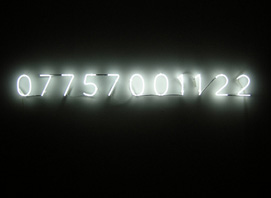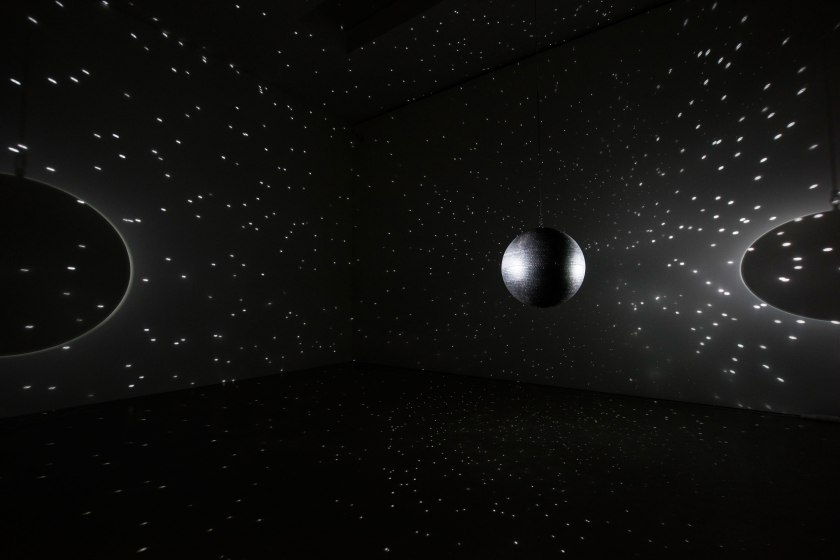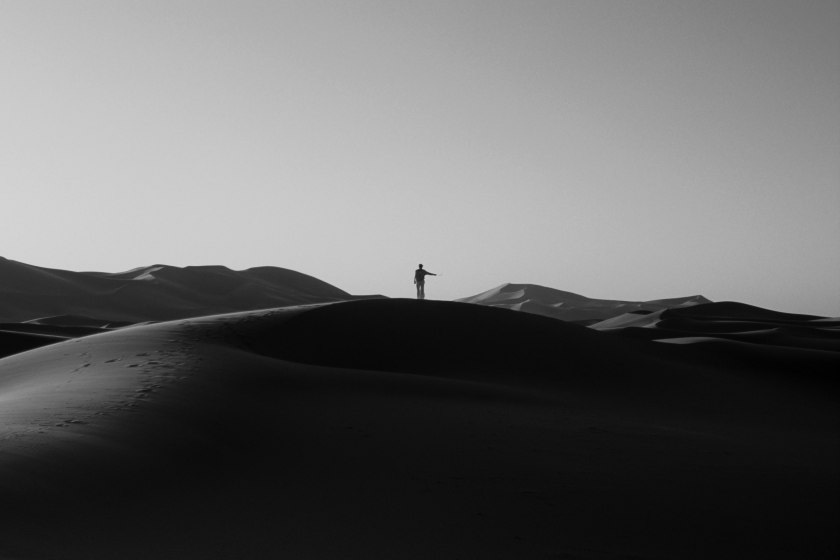“Have a look at the work of Katie Paterson. In particular consider: http://www.katiepaterson.org/vatnajokull/”
“How would you define this piece in terms of media?”

Fig 1. Paterson, K. Vatnajökull glacier (2007-08)
I decided to start with Vatnajökull (the sound of) and then look at her work more generally.
Vatnajökull (the sound of)
I undertook the exercise quite literally initially and so listened to, and researched a little about, Vatnajökull (the sound of) (2007-08). The idea is truly brilliant. We are given a mobile telephone number to call, which would allow us to hear the Vatnajökull glacier melting. In effect we are being asked to listen to what global warming sounds like. There are however, so many layers of thought behind the work. (Sadly, the number no longer works.)
The melting of glaciers is something that doesn’t happen close to many of the world’s inhabitants. Given the very fixed position of Vatnajökull , Patterson brings the melting glacier to us. This in turn changes the nature of the ‘place’ of the glacier. We are connected to something that was distant, but is now close and so fits within our realm of experience and comprehension.
The effects of global warming work on a much slower timescale than human timescales. Another effect of this work, therefore, is to shrink time. We can hear global warming happening now, within a 30 second telephone call rather than watch time-lapse images and/or diagrams illustrating the effects.
Paterson’s choice of this glacier for her work is also interesting. According to the Glacier Guides website (2017), Vatnajökull is “…by far the largest glacier in Iceland and the largest glacier mass in all of Europe…” It goes on to say, “Like so many other glaciers around the world, rising temperatures and reduced snowfall mean that this ancient icecap is melting. In one of the most recent reports from the Icelandic government’s Committee on Climate Change, it warns that by the next century, Iceland’s glaciers will no longer exist.” So Paterson has chosen the largest glacier in Iceland to allow us to experience climate change with a sense of immediacy and proximity; in our place at this time.
According to her website (as above), the following neon sign “…hung in the gallery space.”

Fig 2. Paterson, K. Telephone number for Vatnajökull (the sound of) (2007-08)
The exercise asked how I would define this piece in terms of media. I have absolutely no idea! I am also not sure I understand why the piece needs to be defined. I am happy that we consider it as it is.
Having tried to read around this work, I was forced to accept that highlighting global warming was probably not Paterson’s main intention. In Iceland Review Online (2014), it is stated that Paterson does not consider her work “…political or activist.” The review goes on to quote her directly. “I’m interested in the aesthetics of [the glacier’s] disappearance, the melancholy of its slipping away; as in the Japanese concept ‘mono-no-aware’ expressing ‘the transience of things’ and ‘a gentle sadness at their passing’; in the uncertainty and fragility of now, as reflected in the environment.”
And so the project has to be judged in terms of its aesthetics. I found this hard. As I said above, the idea is brilliant. Whether picking up a phone and hearing the glacier melt is aesthetically satisfying is a moot point. Honestly, for me, it is not enough.
Related work
Paterson has approached the subject of glacial melting in another way. Paterson’s website describes Langjökull, Snæfellsjökull, Solheimajökull (2007) as “Sound recordings from three glaciers in Iceland…” These were “…pressed into three records, then cast and frozen using the meltwater from each corresponding glacier. The discs of ice were then played simultaneously on three turntables until they melted completely.”
Again, I think this is such a creative and interesting idea which, for me, illustrates the nature of climate change in the here and now. Given the quote above, however, it is again necessary to consider the aesthetics of the work. Of course the transience of the piece also reflects and illustrates the transience of the glaciers. The use of glacial ice, instead of vinyl, on the turntables is a masterstroke of irony. Vinyl (as a plastic) is a symbol of man’s permanent mark on the environment, which resonated with the placing of the plastic ball-pen in Sam Taylor-Johnson’s Still Life (2001). I suspect this may have been more interesting to watch as it happened.
Other work
The biography on Paterson’s website explains that her projects “…consider our place on Earth in the context of geological time and change.” It goes on to say that “…her work collapses the distance between the viewer and the most distant edges of time and the cosmos.”
There are two I wish to mention. First:

Fig. 3 Paterson, K. Totality (2016)
Totality comprises a mirror ball that is covered in over 10,000 images of partial and total solar eclipses. As lights shine on it, the ball rotates and so the images are reflected all over the surrounding walls and ceiling. I was lucky enough to see this at A Certain Kind of Light exhibition at The Towner Gallery (https://joeatoca.wordpress.com/2017/05/13/a-certain-kind-of-light/).
The effect of Totality is entrancing on many levels. The rotation of the ball produced an interesting set of images that moved across the room. The direction of rotation and the movement of the images also confused my balance and had the effect of making the whole room feel as if it were turning.
Second;
Inside this desert lies the tiniest grain of sand (2010)
Paterson’s website tells us that, “A grain of sand collected from the Sahara Desert was chiseled to 0.00005mm using special techniques in nanotechnology. This new minute grain of sand was then taken back to the Sahara and buried deep within its vast expanse.”
I think this is another fascinating idea. An entirely insignificant grain of sand is collected. It has now acquired significance. Furthermore, it is reduced in size to make its physical significance even smaller. Yet this adds further to its significance. That is until it is returned to the desert, where it can never be found again and returns to a state of absolute insignificance. The desert is, however, significant now as it is home to the tiniest grain of sand.
I couldn’t help but see a reflection of ourselves and and the strange parallel emotions of feeling significant (to ourselves and those around us) whilst occupying a physically insignificant place in the cosmos.
How is art judged?
As interesting as I found Paterson’s work, my thoughts returned to how art is judged. Is it judged solely on the brilliance and originality of the idea? Does the outcome have to have some aesthetically pleasing element?
This is the image that accompanies Inside this desert lies the tiniest grain of sand on Paterson’s website.

Fig. 4 Paterson, K. Inside this desert lies the tiniest grain of sand (2010)
Is this enough for the project to be aesthetically satisfying? Again, I consider this a wonderful idea but how is this judged aesthetically and who does the judging?
Final thought
When researching Paterson, I came across a newsletter from UCL’s Depatment of Physics and Astronmy dated 5 October 2010. The main story announces that Paterson is to join the Astrophysics Group as their first Artist in Residence, for the academic year 2010-11. I feel that if I try to summarise the newsletter or just select the odd sentence, I simply cannot do the story justice. So please may I invite you to read it for yourselves at https://www.ucl.ac.uk/phys/news/physics-news-publications/ol_10_10
List of illustrations
Figure 1. Paterson, K. Vatnajökull glacier (2007-08) At: http://www.katiepaterson.org/vatnajokull/ (Accessed on 1 June 2017)
Figure 2. Paterson, K. Telephone number for Vatnajökull (the sound of) (2007-08) At: http://www.katiepaterson.org/vatnajokull/ (Accessed on 1 June 2017)
Figure 3. Paterson, K. Totality (2016) At: http://katiepaterson.org/portfolio/totality/ (Accessed on 1 June 2017)
Figuer 4. Paterson, K. Inside this desert lies the tiniest grain of sand (2010) At: http://katiepaterson.org/portfolio/inside-this-desert/ (Accessed on 1 June 2017)
Bibliography
Glacier Guides. (2017) At: http://www.glacierguides.is/vatnajokull-general-information (Accessed on 1 June 2017)
Iceland Review. (2014) Zoe Robert. At: http://icelandreview.com/stuff/views/2008/04/03/dial-glacier (Accessed on 1 June 2017)
Katie Paterson. (2017) Katie Paterson. At: http://katiepaterson.org/biography/ (Accessed on 1 June 2017)
UCL Department of Physics and Astronomy At: https://www.ucl.ac.uk/phys/news/physics-news-publications/ol_10_10 (Accessed on 1 June 2017)
